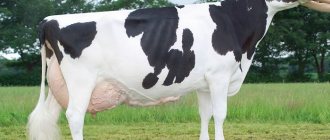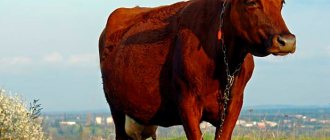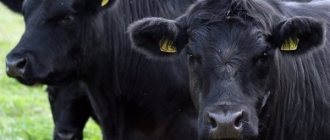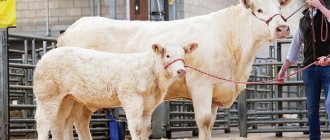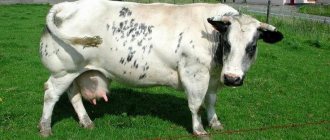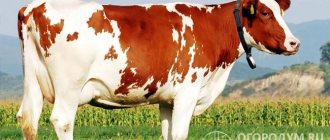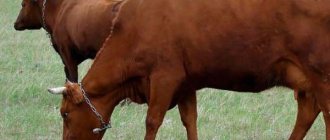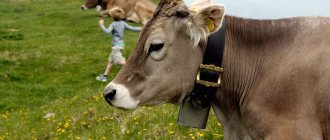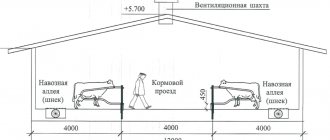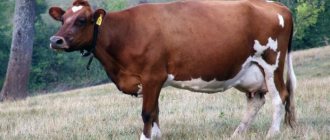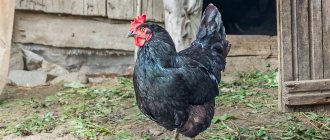Maintenance and care
There are some features here:
- the barn should be clean, dry, well ventilated, but without drafts or blow-ins;
- the place of residence should not be small, spacious, suitable for free movement. The Limousin breed does not tolerate constraint and reacts violently to it. The minimum footage per head must be at least 8 meters;
- availability of feeders and drinking bowls for each animal;
- the flooring is 30 centimeters high and consists of straw or hay;
- stall size – at least 2.1 m x 1.1 m;
- optimal air humidity in the barn is at least 45%;
- on the pasture it is necessary to make a canopy with drinking bowls to be able to hide from rain or heat;
- The barn is cleaned daily to eliminate waste;
- every season it is necessary to carry out full-scale disinfection;
- The main condition is a balanced, rational diet. Subject to strict adherence to the diet, you can achieve the highest quality meat.
Important
Individuals tolerate acclimatization, frost, and heat without difficulty. They get along even at -30 °C. But the most acceptable temperature is considered to be +7 °C.
Appearance and main dimensions
The color of Lebedinsky cattle is gray-brown. On the front of the body and on the sides, the fur acquires a thick dark shade. The lower area of the limbs on the inside is light. Some animals have a gray or dark brown color of varying intensity.
The horns are short, mostly light with darkening tips. The skin is dense, covered with thick, elongated hair. The hoof horn and the tip of the tail are dark. The eyes are small, round, and there is a whitish rim around the nasal planum.
The external and physiological qualities of the breed coincide with the characteristics of the Swiss group. Their difference is noticeable only in growth - Lebedin cattle are slightly taller.
Animals are distinguished by their correct, strong body constitution with the following parameters in centimeters;
- height – 130-136;
- metacarpal girth – 19-20;
- chest depth: 65-72;
- oblique body length – up to 162.
Body weight – up to 550 kg (adult females), 850-1000 kg (bulls).
Maintenance and care
As we mentioned earlier, among the advantages of breeding Limousin cows, one cannot help but highlight their unpretentiousness to living conditions
The only thing you should definitely pay attention to when arranging a barn is dryness, warmth and cleanliness, with a sufficient number of drinkers and feeders.
Summer playground
Summer areas for cows are usually equipped in areas where cattle walk and provide for the organization of the required number of stalls (for each individual in the herd). This option is appropriate in case of seasonal breeding of animals or when the farm is located remotely from good pastures. Being in the fresh air all day, cows produce more milk, and a canopy and fencing on several sides will help protect them from rain or other unpleasant weather conditions. Feeders for the herd This summer housing option is also suitable for representatives of the Limousin breed, the main thing is to provide the cows with free access to drinkers and feeders.
Arrangement of the premises
Limousin cows simply need a spacious room, with a stall size of at least 6–8 square meters. m. per animal. Of course, the entire room must be kept clean and dry, with bedding replaced regularly. It is desirable that the barn has access directly to the pasture, where in the summer the animals will spend the whole day, and in the winter they will only occasionally walk. As for the feeders and drinkers built into the barn, they can be of a standard configuration, for example, along all the stalls or in the form of a suspended tank next to each cow.
Conditions of detention
Despite the fact that cows of the Limousin breed are undemanding animals, characterized by high adaptive capabilities to living conditions, it is still worth knowing about some nuances:
- if the thermometer drops below zero, it’s time to move the animals to a heated room (the optimal temperature for keeping cows of the described breed is +7 °C);
- drafts are unacceptable, therefore, in order to protect the herd, you will have to seal even the smallest cracks in the barn;
- walking cows can be done even in sub-zero temperatures (down to -35 °C), but prolonged exposure to such conditions is fraught with the development of colds;
- The air humidity in a barn with Limousines should be at least 50%, and a constant flow of fresh air is also very important, for which ventilation systems are often installed.
Limousin cows tolerate the summer heat in the middle climate zone quite easily, but if possible, it is advisable to build a place in the pasture with a canopy where the cows can hide from the scorching sun. In such places, drinking bowls are also installed, which must be constantly filled with clean water.
Regular cleaning of stalls and equipment
If cows spend most of their time on pasture, then cleaning the stall and service equipment can be done once a week. In winter, cleaning has to be done more often, since the accumulation of excrement in the barn is unacceptable.
After cleaning the manure, do not forget to pay attention to the bedding, feeder and drinker. In some cases, the flooring layer has to be changed daily or at least once every few days
Disinfection of dry food feeders is carried out several times a month, but drinking bowls are cleaned more often to prevent water from blooming and the proliferation of harmful microorganisms.
Complete disinfection of the barn, including treatment of the walls and all other surfaces, is carried out several times a year, especially if we are talking about large farm premises designed for dozens of animals.
How to care for the breed?
Livestock limousine does not require any special requirements for care and maintenance. But, in order to achieve maximum weight gain and high quality meat, certain points must still be observed. These include:
- balanced regular feeding;
- sufficient free space in the barn;
- high-quality ventilation;
- absence of drafts in livestock buildings;
- Regular cleaning of stalls from residual feed and manure.
It is also important to behave correctly with animals of this breed, since at certain periods of their lives they can show a high level of aggression. In bull calves, this happens at the beginning of pasture after winter stalling. In females, aggressive behavior is associated with a developed maternal instinct. Therefore, careless actions in the presence of a calf can provoke attacks from the mother.
As for feeding, one animal of this species consumes at least 70 kg of feed per day. The basis of the diet for good mass gain and maintaining meat quality are:
- hay;
- roots;
- a small amount of concentrated feed.
Grazing on pastures is included in the feeding plan in accordance with the selected type of fattening. During intensive fattening, the main food for bulls is concentrates, and the animal itself is kept in small pens that prevent excessive physical activity.
Green pasture grass is used as a base
In the case of extensive feeding, the weight of cows does not increase so quickly, but feed is consumed more economically. Green pasture grass is used as a base.
Important! Limousines should be given plenty of clean water at least 2 times a day.
Fertile and hardy
A feature of limousine cows is their high adaptability to climatic conditions. The popularity of the breed is also due to the fact that livestock does not have to be kept in “greenhouse” conditions. In addition, breeders highlight the following advantages:
- precocity of calves;
- the ability to obtain meat from young animals;
- quality products;
- high adaptive abilities;
- endurance;
- high reproductive rate;
- well developed immunity.
Unlike many breeds, Limousin cows have highly developed maternal instincts. If cattle are properly cared for, they will demonstrate excellent fertility results.
Advantages and disadvantages
Before acquiring cattle, it is important to learn both about the advantages of the breed, its productivity, and its disadvantages. Limousines are no exception and have both positive qualities and some negative ones.
- So, the advantages of Limousin cows include:
- unpretentiousness of cows in keeping;
- strong immunity;
- resistance to both high and low temperatures;
- unpretentiousness in nutrition;
- rapid weight gain;
- calm, docile nature of animals;
- Quite a long lifespan - up to 15 years;
- high productivity;
- high-quality lean, dietary marbled meat;
- Meat from calves 1 year of age is already edible and has high taste;
- good ability to reproduce;
- developed maternal instinct in cows.
Did you know? Another advantage of limousines is easy and safe calving. Since newborn calves have a small head, birth can be done without the help of a veterinarian.
Limousines have few disadvantages, but it’s still worth learning about them if you plan to breed this breed of cows.
- Among the negative points are the following:
- the need to have a stud bull, since it is necessary to artificially induce sexual heat in female cows aged 1-2 years;
- a highly developed maternal instinct can lead to an aggressive reaction in livestock to people who approach the calf.
This breed of cows has many advantages, but we advise you to pay attention to the disadvantages of livestock - whether they will become a problem for you and it is better to consider other breeds of cattle or you can cope with the disadvantages of limousines, it’s up to you to decide.
Cows of the LIMOUSINE breed
Origin of the Limousin breed Hungary
The Limousin breed was created in the west of central France in the province of Limousin, an area with harsh winters where cattle breeding was traditionally developed. They tolerate frosts of 20-35 degrees Celsius and snowstorms, provided there is plenty of roughage and mandatory protection from the wind. The breed was created by improving local Aquitaine cattle of the working type of rough constitution.
Subsequently, they began to improve the cattle mainly in the direction of meat productivity with simultaneous assessment of its exterior. The best animals began to be exhibited at exhibitions. In 1856, a studbook of Limousin cattle was founded. In the second half of the 19th century.
carried out selection for meat qualities and early ripening, for the massiveness of livestock and for the production of lean carcasses. In breeding, the role of the origin of animals and the evaluation of bulls by the quality of their offspring increased. Since 1925, a closed type stud book began to be published. In the first half of the 20th century.
The selection of livestock for meat qualities and early maturity continued, and the creation of lines and related groups in the breed began.
The color is red, light on the stomach. The head is short, with a wide forehead. The body is well muscled. The chest is rounded, but not deep enough, the back is very wide and level, with highly developed muscles, the muscles of the ham are well developed.
Animals of this breed are valued for their unpretentiousness, endurance, good use of pastures, high fertility, and excellent quality of carcasses and meat. In France, the weight of newborn bulls is 36-42 kg, heifers - 34-38 kg, sire bulls - 1000-1150 kg, cows - 580-640 kg.
The live weight of bull calves at weaning at 7-8 months of age is 260-300 kg, of heifers - 240-260 kg. The breed was introduced at the same time as the Charolais. The live weight of cows is 550-580 kg, newborn calves are 32-40 kg. The calf yield is 90-95%. The live weight of calves at weaning at 7-8 months is 220-240 kg.
The slaughter yield of Limousin bulls is 63-64%. meat in the carcass - 82-83%. For 1 kg of bones there is up to 6.5 kg of pulp. fat in meat - 7-10%, protein - 19-20%.
Limousin cattle have good acclimatization abilities, can withstand harsh conditions relatively easily, and make excellent use of pastures, incl. mountain The milk productivity of Limousin cows is quite high (1500-1800 kg.
), and the live weight of suckling calves reaches 240-300 kg at weaning. (6-8 months). In terms of meat productivity, limousines are early maturing, intensively growing animals. Their carcasses are already 12-15 months old. At age they are distinguished by very high clarity, mature meat and well-defined marbling. With intensive fattening, bulls by 15 months.
reach a live weight of 450-500 kg. and their carcass yield is 58-60%.
The Limousin breed produces a wide range of end products: from dairy calves to heavyweight heifers, as well as various types of young stock.
The peculiarity of the breed is in obtaining the final product regardless of the age of the animal and the ability to adapt to production conditions.
In terms of the market value of products and the profitability of maintenance, the Limousin breed is the most effective for livestock breeding.
Limousin cattle began to be imported into our country in 1961. The leading breeding herd of the breed was located at the Priozersky state farm in the Brest region.
Animals of the Limousin breed rank second in number in France, successfully competing with the Charolais breed in terms of distribution in the world.
Both breeds are widely used in crossbreeding with dairy cattle and in the creation of new breeds of beef cattle.
Share the information with your friends and family!
Interesting facts from the history of cattle
The Limousine breed originated in a small province in southwestern France (as of 2021, this area belongs to the New Aquitaine region). The first mention of it appeared in 1850, and the ancestor was Aquitanian cattle used as draft power.
Read also: System and methods of keeping cows
Initially, breeders chose three directions for the development of livestock: dairy, meat, working, but later settled on improving its meat characteristics. Later, selection was aimed at reducing fat content and increasing muscle mass.
In 1865, a studbook of the Limousin breed was published, and from 1925 to 1961 it switched to a closed format (data on purebred animals was entered on its pages, excluding crossbreeds).
Since the second half of the twentieth century, French livestock breeders introduced a special feeding system designed to produce valuable meat from young bulls about 1 year old and calves at 3-4 months of age. By the end of the century, Limousin cattle became the No. 2 breed in France, losing primacy to the Charolais tribe.
Breeders exported cattle to Hungary, Canada, England and other countries as a gene pool for dairy and meat lines. In 1961, the species appeared on the territory of the USSR. The center of its breeding was the Priozersky state farm (Brest region, Belarus).
Content Features
Caring for and maintaining the Aberdeen Angus breed does not cause much trouble. The Aberdeen livestock tolerates climate difficulties well, and therefore does not require equipped or insulated premises. The exception is in regions with high humidity - dampness leads to a decrease in productivity, so it is better to take care of good shelter.
Activities for caring for the Aberdeen Angus cow breed are common - regular cleaning of the barn from feces and debris. The livestock's access to fresh water is important - for normal functioning of the digestive tract, drinking bowls need to be washed 1-2 times a day and the water in them changed.
Aberdeen dogs are not tied up in the barn as they get along well with each other
Calving Features
Pregnancy in Angus cows lasts 9 months, after which 1-2 newborns are born. The weight of calves is 15-23 kg - due to their small size, birth is easy and requires virtually no human intervention. Before calving, females become restless, so it is better to isolate them so that they do not harm themselves. Normal labor lasts no longer than half an hour - if the fetus is not born 30 minutes after the water breaks, outside intervention is necessary - to eliminate the possibility of problems, it is advisable to consult a veterinarian.
Babies have good immunity and rarely get sick or die. Representatives of the breed have a pronounced maternal instinct, so they independently take care of their offspring. The only problem that a farmer may encounter is that when weaning calves from cows, they often show aggression, even if the young animals are already quite old.
Calf care
After the calf is born, it is necessary to wipe off mucus, place it on a clean cloth, cut the umbilical cord to 10-14 cm and treat the cut with an antiseptic. The baby can be left with the mother so that she can take care of him herself, or he can be dried and taken to another room. After about 2 hours, he should begin to get up on his feet - if this does not happen, you should contact a veterinarian, as this indicates health problems, most often a lack of oxygen.
Aberdeen Angus calf
The cow feeds the offspring for 8 months, after which it begins to feed on its own. To make care easier, you can start feeding young animals from the first days of life - feed mixtures, premixes, and crushed grain are used as supplementary feeding. Aberdeen calves gain weight well - by 9-10 months they weigh about 250 kg.
Feeding
In regions with sufficient fresh grass, the breed of cattle can be kept on free grazing. Such nutrition has a good effect on the quality of meat - it acquires a delicate and delicate taste. In addition to succulent feed, containers with mineral supplements should be placed near the area where the cows graze.
In winter, the livestock is switched to dry feed - hay, crushed grain, feed, minerals and vitamins. To achieve good weight gain (about 1 kg per day), Aberdeen requires the following feed rates:
- 6.5 kg of dry oats;
- 32.5 kg of fresh grass;
- 13 kg of average quality hay.
It is not recommended to overfeed representatives of this breed, as they are prone to obesity, which will negatively affect their health.
Calving and its features
The optimal months for mating are summer and spring months. Calves born during this period quickly gain weight by eating grass. Calving females also quickly get into shape. Nutrition is the most important factor during calving, since with its help the cow and calf gain strength, energy, nutrients, minerals and vitamins for full recovery. The optimal age for calving is 20 months. Over the course of 7-8 years, reproduction does not decline.
Two weeks before the planned calving, a separate room (stall) should be prepared, covered with straw. It must be clean, dry, disinfected. In case of bad weather, a week before calving, the female is transferred to a stall and kept there for another 8 days after the calf is born.
The first sign of labor is condition. She is restless and constantly gets up and lies down. During normal labor, the calf will be born with its front legs forward, on which the head rests. A cow licks the head of a calf. The umbilical cord breaks on its own. If this does not happen, you need to trim it with sterile scissors.
After half an hour, the cow should be given water and salt (10 liters) to drink. This will help you recover, balance water metabolism, and prevent udder disease. You need to make sure that the calf can suckle the udder on its own. If he is very weak, help him stand up. Vitamins A, D, E are applicable.
Important
It is necessary for the cow and calf to live separately for several days, this helps strengthen the maternal instinct. After a week, they are transferred to a room for 5 individuals for adaptation. And only after this can they be moved to the main group barn.
It is important that the cow and calf live separately for several days, this helps strengthen the maternal instinct. After a week, they are transferred to a room for 5 individuals for adaptation. And only after this can they be moved to the main group barn.
Calves of the Limousin breed
They are born weighing about 40 kg, although often the weight can be less - 20 kg. This is a natural phenomenon and is not associated with disease or other problems. This way, young animals are better preserved and calf mortality is minimal. Weight gain is on average 800-1000 grams. Heifers gain weight more slowly than bulls.
The sucking reflex is well developed. Limousin calves soon look for food on their own and try to stand up. It is necessary to periodically conduct veterinary examinations of young animals to eliminate problems in the early stages. I wean cubs from their mother at the age of 7-8 months, determining the sex and further purpose. Until a month of life, the calf feeds on milk, then on grass or hay.
Productivity indicators
Cattle of Limousin origin are characterized by low milk yield. They range from 1300 to 1800 liters per year. The fat content is no more than 5 percent. Among other important indicators, the protein content of 4.3% should be highlighted. Keeping this individual to obtain milk yield is an irrational decision.
The main purpose of breeding the Limousin breed of cattle is to obtain meat. Depending on the scheme and intensity of feeding cattle, you can get a return in the shortest possible time or achieve a greater increase in useful mass by increasing the maintenance period.
When a Limousin calf is born, its weight is about 40 kilograms. Individuals of this breed can be prepared for slaughter in the following periods of time:
- from 6 to 8 months – the cow’s weight will be in the range from 300 to 450 kilograms;
- 15 months – with weight reaching from 500 to 550 kg.
With a properly formed diet for Limousin calves, it is possible to achieve daily weight gain at a rate of 800 to 1000 grams.
Due to the gender characteristics of cows, their total maximum weight is usually limited to 700 kg. And the maximum weight of breeding bulls reaches 1300 kilograms.
The structure of meat consists of fibers with a minimal content of fat cells. It is a marble type of the highest quality. After slaughter of an individual, the resulting net volume of meat products from the total mass is in the range from 60 to 65%.
Characteristic external signs
The Limousin breed has a strong and weighty body. In this case, enlarged muscle fibers are observed. The following features are also highlighted:
- the coat is distinguished by a golden-brown hue, which changes to light in the lower part of the body without any spots or pigmentation;
- shortened head with a wide forehead;
- the skin has a high elasticity index;
- hooves and horns have a lighter shade compared to the fur;
- the limbs are of medium length, but quite strong;
- well-formed udder with equal shares and compact dimensions;
- a short neck with folds of skin, which systematically merges with the broad chest. Its girth size is about two and a half meters;
- The height of the individual is in the range from 1.3 to 1.4 meters, taking into account the withers.
The purpose of breeding this breed is to obtain meat.
Characteristics of animals of the Limousin breed of cows
The bone skeleton is well developed, the muscles have a pronounced structure, and adipose tissue is minimal. The front part of the body is large, the back part of the body is rounded. The limbs are stable, of medium length, with well-developed muscles in the thigh. The horns and hooves are light in color, the head is not long, the frontal part is large, the neck is short and has a dark shade, sometimes you can see folds of skin that go down to the chest area. The height at the withers is 1.3-1.4 m, the chest girth is 2.2 meters for a cow, 2.4 m for bulls.
Productive characteristics
Since the breed belongs to the meat category, milk productivity is low. During one lactation period, milk yield is 1.3-1.8 tons, but milk with an average fat content of 5%, protein 4.3%. Newborn calves are of average size and weigh 30 kg and can sometimes reach up to 40 kg. Since the calves are not large, birth in Limousin cows is quite easy, and the young animals have a high survival rate. The average daily weight gain is 800-1000 g; after 12 months, adult bulls can weigh 500 kg or more, and cows about 400 kg in a year and a half. Bulls of the Limousin breed reach a live weight of 900 kg on average, and breeding representatives of this breed have a live weight of up to 1300 kilograms or more. Sexual dimorphism is also present in this breed. The maximum possible live weight parameters for cows is 700 kg, the average meat yield is 65% and can reach up to 70%. Depending on the feeding method, different productivity is distinguished.
- If extensive fattening is used, that is, natural walking, then the young animals are suckled by the cows for a long time. There is also pasture housing, then fattening is more economically profitable, but the weight of cows takes quite a long time to gain and increases on average by several months;
- If intensive fattening is used, then the bulls undergo castration, but are kept all this time in specially prepared pens where movement is limited. Fattening is carried out with concentrated feed; high feed consumption brings a rapid gain of muscle mass. Thanks to a variety of fattening methods, it is possible to obtain meat with marbling, good taste and a delicate texture.
Advantages of the Limousin breed
Limousin cows have the following advantages:
- Meat products are of excellent quality, highly valued by consumers, and have a juicy and delicate taste;
- Good fertility, excellent hunting period, high fertilization rate;
- Cows are unpretentious to the conditions of keeping different methods of feeding; you can use various feeds for feeding, resulting in good productivity indicators;
- Animals quickly gain weight, have a high meat yield, and are very productive.
Cows of the Limousin breed are used as genetic material for creating new breed lines, or improving the productivity of already known breeds of cows. Since in the meat sector there are breeds that are much more productive and quicker, but the resulting products from limousines have unique meat quality and good popularity among livestock breeders.
Breeding
Limousins, like representatives of other meat breeds, have seasonal cycles. The calf is suckled for a long time, so the sexual heat of the lactating female is restrained.
In such cows, a “silent heat” is often recorded, which does not appear outwardly. However, they try to work with the herd so that the heifer and the cow give birth to a calf every year.
The freestyle mating method is most suitable. To shorten its duration, stimulant drugs are used. Pregnancy testing is carried out two months after the last contact of the female with the male.
Attention! Cows with a negative result, as well as those in which abnormalities of the reproductive organs are detected, are culled into a separate group and adequate therapy is carried out, interfering factors are eliminated - an unbalanced diet, unsatisfactory living conditions, etc.
If even after these measures it is not possible to achieve results, the cows are finally culled. Purebred breeding of Limousines is practiced.
Meat quality is improved due to the following factors: culling of individuals that violate established standards; sires must be purebred; consanguineous matings are prohibited.
Every 3 years they change producers, attracting them from another line. Compliance with these principles allows you to obtain productive livestock.
Productive characteristics
The characteristics of the meat and dairy Simmental cattle breed are quite high, but they have some disadvantages. Cows are not known for their early maturity - the first litter can be obtained at about 2.5 years, but young animals are born large and quickly gain weight. Simmental bulls can weigh about 1000 kg, females are slightly smaller, but in rare cases reach a similar weight. The meat is high-calorie, with delicate fibers, the yield is 55% for females and 65% for males. Disadvantage: High bone content.
The milk performance of this type of cattle is also quite high - 5-5.5 thousand liters of milk can be obtained from a cow per season. The product has a fat content of 3.9-4.2% and low protein content, which makes it popular in all countries of the world.
Childbirth and calf
It is noted that Charolais cows can have difficult births, since the calf is born large. Therefore, you need to be present at the birth and, if necessary, help the animal. It is necessary to ensure that the calf drinks colostrum after birth, as this is the key to its future health. Cows accept calves without problems and begin caring for them immediately after birth.
For breeding, you need to choose purebred animals, bulls and cows, in order to maintain the purity of the breed. In this case, inbreeding must be avoided, so for mating it is necessary to select males and females belonging to different lines. The sire is used intensively for 2-3 years. When crossing Charolais bulls and female cattle breeds, crosses are obtained that are characterized by accelerated growth, size, weight, and productivity.
Breed overview
Limousin cows easily tolerate cold, adapt to different weather conditions and acclimatize well. That is why they are bred in different countries of the world and in different climatic conditions. In addition, they gained their popularity due to their unpretentiousness and high fertility. Burenki make excellent use of pastures even with short grass, including mountain meadows. It is believed that this breed is the most effective in beef cattle breeding.
Today this breed is successfully grown in France, where it ranks second in number after Charolais, in England, Belgium and many other European countries. Limousin cows were first brought to Russia in 1961. At that time, the leading breeding farm for this breed was in the Brest region at the Priozersky state farm.
Origin
This cow has nothing to do with a limousine, or rather a car, and received its unusual name from the French province of Limousin, where it was first bred in the second half of the 18th century. This area has a very harsh climate with cold, windy winters, so the breeders were given the task of breeding cows with good frost-resistant abilities. So, as a result of selection work on local Aquitaine cattle, this breed was obtained.
Initially, breeders received a breed with working milk and meat qualities, but later repurposed it completely for the meat type of productivity. By the beginning of the 19th century, breeders demonstrated the best Limousin cows at an exhibition, and in 1856 the first stud book was created.
In the first half of the 20th century, breeding farms continued to improve the meat performance of cows, as well as their early maturity. Animals began to be purposefully fattened in stalls to subsequently obtain high-quality meat. By the way, today the products of the Limousin breed are quite expensive and are provided to leading restaurants in France.
Appearance
Compared to most meat breeds, Limousines are distinguished by their delicate build and small stature. The color is only red, more or less bright with a light belly. The animals have a wide back, a rounded chest, a long rump, strong bones and very well developed muscles. The head is short and with a wide forehead, there are short horns. We offer a more detailed look at the external appearance of these cows in the photo.
Productivity
Despite the fact that the Limousin breed is a meat breed, their milk production is also good - about 1500-1800 kilograms. In terms of meat productivity, these cows occupy one of the leading places in terms of quality. Since cows are early maturing, by 6-8 months the calves reach a weight of about 300-440 kilograms and in some farms they are already sent to slaughter. Due to this, producers obtain unusually tasty, juicy and lean meat.
With intensive fattening, bull calves are raised for up to 15 months. Then they reach a weight of 400-500 kilograms and give 60% of the product yield - marbled meat. Adult cows gain weight up to 600 kilograms, males - 1000-1100 kilograms. They have very good productive qualities in terms of body structure - for 1 kilogram of bones there is about 6.5 kilograms of meat.
The Limousin cow breed is valuable for its dietary meat. In the era of healthy eating, the demand for cattle beef has increased significantly. This article presents the characteristics of the animals and provides a full overview, including photos. Cows, bulls, and calves of the Limousin color are clearly visible in the photographs.
Farmer reviews about the breed
Ksenia. On our small farm, Limousin cows have been raised for 10 years. The bulls grow quickly, and we slaughter them for meat at one year of age. Heifers are used to produce young animals. You will not get milk from these cows, since the calves suck everything. If calves are taken from their mother early, they will not grow well and the mother will become stressed and angry. We tried to use intensive fattening, but after calculating the cost of feed, we abandoned this method. Pasture farming is much more economically profitable, since there is enough grass in the summer.
Andrey. Limousin bulls are simply beautiful. It's a pity, but they were born to die. An incredible amount of meat is obtained from bulls from the age of one and a half years. The quality of the meat is tender, tasty, marbled. Sold without problems. I can definitely say that this is the most profitable breed for beef cattle breeding.
In the video you can see a breeding bull of the Limousin breed at an agricultural exhibition.
Advantages of polled breeds
The key advantage of hornless cow breeds is that there is no risk of injury to other animals in the herd. It is often observed how horned males start fights with relatives for leadership. In this case, it is not only animals that are injured. Bulls can also show aggression towards those people who care for them.
Cows of polled breeds are unpretentious to living conditions. They can be successfully kept in a cramped stall or without one at all. An important advantage of such animals is their cost, which is lower than the cost of their horned relatives. Hornless cows are unpretentious in their diet - even if there is no large amount of fresh grass on the menu, their performance does not decrease. Polled cows quickly get used to a new type of food. They are stress-resistant, easily tolerate changing circumstances and quickly get used to their new owner.
Horned cows also have certain advantages over hornless ones. Thanks to their horns, animals can protect herds well from attacks by predators. Also, females with horns are more attractive to members of the opposite sex and can compete for food. In horned cows, antlers are an indicator of health and age. And in cows of polled breeds, indicators of health and age are teeth, udder and belly.
Calf care
In the first months, the main food product is milk. Then the diet is gradually expanded.
The type of food depends on age:
- 1 month - colostrum;
- from 2 months - the main food is milk, but hay, dry food, and root vegetables are gradually introduced;
- from 3 months - the portion of milk is reduced to 5 liters, the amount of hay, vegetables, grain is increased;
- By six months, they are transferred to adult food and weaned off milk.
During the period of active growth of young livestock, intensive and extensive types of fattening are used.
The calf's main food product is milk.
Intensive
This method involves keeping animals in pens where minimal activity is possible. The main diet is concentrated feed. The advantage of this method is the rapid growth and development of young animals. The disadvantage is high costs and increased cost of meat.
Extensive
The second method of fattening significantly reduces costs, but slows down weight gain. The lag is 2–3 months.
The diet includes the following products:
- hay;
- silage;
- root vegetables - potatoes, beets, carrots.
In summer and spring, the diet is supplemented with fresh grass from pastures.
In summer, cows feast on fresh meadow grass
Table 2. Example of a daily diet for calves
| Type of feed | For a calf 9–12 months, kg | For a calf 13–16 months, kg |
| Corn silage | 8 | 10 |
| Grain hay | 2,7 | 3,5 |
| Fodder beet varieties | 2 | 3 |
| Legume hay | 1 | 1 |
| Straw | 1 | 1 |
| Concentrated food products | 2 | 2,2 |
| Table salt | 45 grams | 50 grams |
| Calcium phosphate | 35 grams | 45 grams |
| Feed sulfur | 6 grams | 8 grams |
Before feeding, vegetables are peeled and boiled. They can be mixed with cereals.
Cattle are watered 2 times a day, pregnant cows - at least 3 times. Water consumption reaches 70 liters.
Peculiarities of meat production in cattle breeding
Origin of the Limousin breed, its prevalence
The limousine is an animal with French roots. It was in France, in the central part of the country, that this suit was developed. The name comes from the province where the Limousin breed of cattle, the Limousin, began its journey in the 13th century. The ancestor is considered to be Aquitanian cattle. He was physically very developed and strong.
The impetus for selective breeding was the transition from working and dairy functions to the meat direction in cattle breeding. It was decided to improve the taste of meat by developing an ideal color for these purposes. The results of such experiments prompted breeders to exhibit cows at exhibitions. The origin and quality of the bull were considered important characteristics. These requirements have survived to this day.
At the end of the twentieth century, pastoralists came to the conclusion that it was necessary to improve the taste of meat by slaughtering it at a young age. Through experimentation, breeders have developed the ideal meat breed, which is now most in demand. Meat from cows of the Limousin color is one of the most expensive in the world. Appearance and early maturity are additional goals of cattle breeders. At the end of the 19th century, a closed type stud book was created.
The individual came to the territory of Russia only in the sixties of the last century. Today, the distribution of Limousines is quite extensive. About seventy countries breed Limousin cows. The largest farms are located on the American continent, in Portugal, Australia
Regarding France, exported beef occupies an important place in the country’s economy
Origin story
The initial process of breeding the Limousin breed is recorded in the mid-18th century. The final formation of individuals occurred at the beginning of the 19th century. Subsequently, steps were taken to increase the rate of carcass weight gain. The name of the breed is due to its place of origin - the Limousin suburb in France. The genetic ancestor of the Limousin individual is considered to be Aquitanian cattle. He had increased strength qualities.
Subsequently, the breed was distributed in Portugal, Australia and America. The Limousin cow first entered the territory of the Soviet Union in 1961. The initial export of the French beef breed was to Brazil in 1886. Then Argentines, Uruguayans, etc. began to purchase limousines. Moreover, only in New Caledonia was it possible to form a herd of new offspring of cattle.
The decisive move to gain high popularity of the Limousin breed was made in 1968. It was marked by the transfer of a bull of this individual to Canada. The very next year, the animal's sperm was provided to the United States of America.
Today, the French beef breed of cows can be found in more than 17 countries.
Limousin bull breed
general characteristics
Aberdeen cattle are meat-oriented and have specific characteristics. Aberdeen are hornless cows and bulls, the key characteristic of which is polledness, which is inherited with 100% probability. Most often, animals are black in color (Black Angus cows and bulls); less common are representatives of the breed of a brown shade, which are called red.
Red Aberdeen Angus cow with calf
Origin and distribution
The Aberdeen Angus cow breed was developed in Scotland in the 18th century, and its ancestors were used as draft animals. The name comes from two regions of the state where the selection and development of a new variety of cattle was carried out. At the end of the 19th century, 8.5 thousand heads of cattle were brought to the USA, which is where the spread of Angus began - the first association of Aberdeen breeders was organized in America, which still exists today. The breed is common in North America, Europe, and some Asian countries, especially in regions with unfavorable climates.
In which countries is Aberdeen Angus grown?
Angus are grown not only in the USA, but also in Australia, Great Britain, Argentina, New Zealand, Canada and Japan. The breed appeared on the territory of the former USSR in the 30s, but immediately gained popularity. It is bred in areas with difficult climatic conditions - Kazakhstan, which is characterized by temperature changes and frequent droughts, in Altai, some regions of Ukraine, in the Volgograd and Orenburg regions.
Breeding Aberdeen Angus cattle
Description
The breed of Limousin cows came to us from the French regions, known for their vast pastures. Representatives of these cattle have excellent growth rate characteristics.
The Limousin breed is an exceptionally lean breed used to produce premium meat products. Cows and bulls are characterized by uniform, bright wool of a reddish-wheat color. Calves grow large in size, with short heads and inward-curved horns.
These largest cows were first exported from France in large numbers in the 1960s and are now kept in approximately 70 countries. Cattle of this breed were originally used as draft animals; interest in limousines as a source of high-quality meat grew about 200 years ago.
Limousines became popular due to the low birth weight of calves.
With quality feeding, these cows gain weight faster. When breeding the breed, livestock breeders focused on increasing milk production and the level of slaughter weight.
The main features should be noted:
- the head and neck are larger than those of other breeds;
- the chest, like the back, is wide;
- the legs are short, but have well-developed muscles;
- the udder is well developed.
The weight of an adult cow reaches 545 kilograms; for bulls this parameter is at the level of 1100 kg. At birth, calves weigh about 400 kg, after they are weaned from their mother they quickly gain weight: the gain is up to 110 grams per day.
One cannot fail to mention the cool disposition of the representatives of the described breed. Bulls become especially aggressive after a year or during the first time after being out on open pasture. Cows exhibit this behavior only after calving, when a calf is nearby. During these periods, experienced livestock breeders advise to be especially careful when dealing with Limousin cows. A stranger, if there is no owner nearby, should not approach the animal at all, since it is very difficult to predict the behavior of a bull, and given its mass, you can suffer greatly.
This breed is more meat than dairy. An adult heifer produces only 1,800 liters of healthy drink per year, and the milk has a high fat content, since the described parameter is at the level of 5%.
What is prized in the breed is the meat, as it is soft; Despite the fibrous nature, the fibers are thin, without the presence of fat in the carcass. Calves are slaughtered already in the eighth month after birth.
What to feed
Limousin cows do not need any special feed, and they gain weight well on standard feed mixtures, hay and grass
However, when preparing a diet, it is very important to take into account the season in order to supply the animal’s body with the maximum amount of useful microelements and vitamins.
Summer walk in the pasture
One cow of this breed consumes about 50–70 kg of feed per day, which is explained by rapid weight gain. In summer, the lion's share of this value is occupied by grass, which animals can easily get when grazing on pastures
The main thing you should pay attention to is the absence of foreign objects in the selected area in the form of plastic bags, paper and other debris that can get stuck in the digestive system of animals. In addition to fresh grass, it is useful to give Limousin cows about 3 kg of hay (per individual per day) and 2 kg of concentrates, supplementing the diet with root vegetables (carrots, beets, Jerusalem artichoke and potatoes are especially useful)
Differences in feeding in winter
The main difference between the winter diet is the absence of fresh grass, which is usually replaced with hay, but 1 cow should not have more than 10 kg of such feed per day. If possible, you can mix it with oat straw, which Limousin cows love. In this way, feed costs can be reduced. The bulls, which the farmer plans to soon send to slaughter, are kept in separate pens, with a minimum of physical activity, but regular walking. The main components of their diet are concentrated feed (about 6 kg per head), melons (about two buckets per day), and hay. Despite the fact that the material costs of purchasing these feeds are quite high, the animals grow several times faster and this justifies such an intensive method of fattening. Typically, bull calves are taken to slaughter at the age of 11–12 months, with a body weight of 700–800 kg.
As for water, in winter there is about 45–50 liters per individual of the Limousin breed.
The approximate diet of Limousin cows during their life is as follows:
- at one month of age, the calf eats only colostrum;
- from the second month of life, he is given hay and vegetables (together 500 g), as well as 100 g of grain mixture per day (mother’s milk is still the basis of his diet and he can drink up to 10 liters per day);
- in the third month of life, the portion of milk is reduced to 5 liters per day, but the amount of hay, vegetables and grain mixtures given increases to 1.5, 2 kg and 300 grams, respectively;
- closer to six months, the calves are completely transferred to adult food, giving them 3 kg of hay, 4 kg of root vegetables and 1 kg of grain mixture per day;
- after 7–8 months of life, young individuals can eat as much hay as they want, and their general diet is supplemented by 10 kg of vegetables (necessarily chopped) and 2 kg of grain mixture; these proportions should be adhered to until the calf is ten months old;
- in the future, the amount of vegetables is increased to 12–15 kg per day, grains to 5 kg, and the rest of the diet will be taken up by hay and silage in winter or fresh grass in summer.
The main source of useful elements for calves among melon crops will be pumpkin and zucchini, and among root crops, sugar beets and carrots deserve special attention. In winter, some vegetables can be replaced with haylage or silage, which animals eat just as eagerly.
Limousine catering
Rare, special foods are not needed. Cows are content with grass, hay, and feed. The main condition is to supply the maximum amount of microelements, macroelements, nutrients and vitamins during the spring-summer period. To do this, you need to walk on ecologically clean pastures, preferably throughout the day.
Every day the animal eats 70 kilograms of food. This promotes rapid weight gain. In summer, the basis of nutrition is grass. When choosing a walking location, it is important to choose areas free of garbage and all kinds of objects. Otherwise, it may enter the digestive system and cause irritation.
In addition to herbal foods, other foods should be present in the diet. The ideal combination is 3 kilograms of hay and feed per head, as well as potatoes, carrots, beets, and Jerusalem artichoke. Vegetables should be thoroughly washed and peeled, preferably boiled.
A prerequisite for keeping any animal is clean drinking water. One individual receives up to 90 liters of water per day, in winter – 50 liters. When grazing, cows are given water 2-3 times.
In winter, when there is no fresh grass, they are fed hay. It is necessary to comply with the norms, no more than 9 kg of hay per animal. It can be mixed with oat straw. The limousine loves her.
Bull calves, which are prepared for quick slaughter at one year of age, live in separate areas without active movement, but with frequent walking. Food consists of hay, melons, and mixed feed 5 kg per day.
Advantages and disadvantages
The Simmental cow has pros and cons compared to other types of cattle.
The advantages of the breed include:
- meat and dairy focus - livestock can be raised for both meat and milk;
- unpretentiousness to living conditions, care and nutrition;
- rapid development of young animals and good growth;
- Cows have excellent maternal qualities - they independently care for their offspring and feed them for a long period;
- the ability to cross representatives of the breed with other varieties of cattle - they are often used to improve the characteristics of livestock;
- high immunity - the livestock rarely gets sick and does not require much attention;
- good life expectancy - Simmental cows live about 10-15 years and are able to produce milk almost all this time;
- Not only the meat and milk of Simmentals, but also their skins are highly valued on the market;
- representatives of the breed can perform heavy types of agricultural work;
- calm and docile disposition - animals get used to humans and rarely show aggression.
Simmental cows are unpretentious to living conditions
Simmentals also have disadvantages - first of all, these are minor productivity shortcomings that can affect the farmer’s profit. The meat of representatives of the breed is tender and has good taste, but contains a large number of bones, which reduces its quality. A similar situation is observed with milk - low fat content and protein concentration negatively affects the cost of the product.
Diseases and their treatment
On farms and in premises where livestock are kept, deratization and disinfection are mandatory. It is prohibited for unauthorized people and other animals to enter the territory of the enterprise.
Newly arrived individuals are sent to quarantine for at least a month. A mandatory measure is to prevent cases of mastitis arising due to bacterial, technological, or cold factors.
To prevent illness, provide proper care, maintain hygiene, and provide daily exercise.
There should be enough phosphorus in the diet. Breeding stock is subject to regular obstetric and gynecological examination. Stillborn fetuses and abortive material are sent for laboratory testing within 24 hours.
Description, characteristics and defects of the breed
The Simmental breed of cows is difficult to confuse with other varieties of cattle. The height of a cow at the withers is about 130 cm, bulls are slightly higher - up to 150 cm, the weight of females is 550-650 kg, bulls reach a weight of 850-1000 kg. The description and characteristics of the Simmental breed are as follows:
- standard color – light, sometimes with variegated spots on the sides;
- wide bones with well-developed muscles;
- withers of medium length, smoothly flowing into a straight back;
- The lower back is oblong, the sacrum is on the same line with it;
- wide croup;
- powerful, short neck, bulls often have a dewlap and double withers;
- the head is large, with a massive, convex forehead;
- horns are well developed, light, with brownish tips;
- the legs are even, straight, the hooves have a pink tint;
- heifers have a round, large udder with elongated nipples;
- the tail is very long, with a tassel at the end.
Simmental breed of meat and dairy cows
The general appearance of the animals is quite rough and massive, and the cleanliness of this type of cattle can be checked by examining the eyelids and nose. Their shade should be even and pink - the spots indicate that the representative is not a pure breed. Sometimes Simmentals have a defect - the back pair of legs are located wide, like an elephant's.
External differences between limousines
You can recognize the Limousin breed of cows in the photo by color. The animals are covered with red fur, smoothly turning into light colors in the belly area. The short head is distinguished by a wide frontal bone and short, downward-pointing horns. Limousines have fairly well developed muscles.
The photo clearly shows that both cows and bulls of the Limousin breed are distinguished by the harmonious forms inherent in meat representatives of cattle.
The height at the withers reaches 1.4 m. The body of the animals is distinguished by its massiveness with a rounded chest, a wide, even dorsal region, an elongated sacrum and developed muscles of the limbs. The layer of subcutaneous fat is quite moderate.
High-quality care and provision of proper nutrition preserve the vital activity of these animals for 15-16 years.
Advantages
Of course, limousine cows have gained wide popularity due to the wide range of advantages that they possess. Among the main advantages of the breed, the following come to the fore:
- Unpretentiousness to living and feeding conditions. Due to the Limousin climate in which the cows were raised, they are well adapted to cold regions and can graze even on mountain meadows with sparse vegetation.
- Good survival and early maturity of young animals. By the age of one, the meat acquires such valuable marbling and the animal is ready for slaughter.
- High fertility, which can reach 90-95%.
- Immunity to most diseases to which other breeds of cattle are prone.
- Quick adaptation to different climatic conditions.
- High yield of delicious meat from the live weight of the animal.
High fertility in the breed
It is also worth noting that limousine cows calve easily and do not require serious intervention from the owner or staff.
